The Best Shoes for Kids with Down Syndrome – Protect Their Feet!
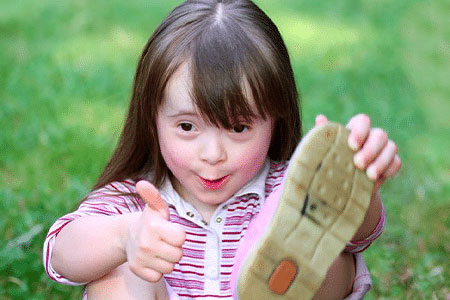
I have noticed through the years that children with Down syndrome tend to have flatter, wider, and more pronated feet that usually require a specific type of shoe. The best shoes for kids with Down syndrome provide a stable base of support, round toe-boxes, and oversized openings for easy on and off.
If you’re pressed for time, you can jump directly to the selection of the best shoes for kids with down syndrome.
Do Most Children with Down Syndrome Have Flat Feet?
Most children with Down syndrome who visit the shoe store where I work have flat feet.
The main issue with your child being flat-footed is that their arches can’t act as shock absorbers every time your kids’ feet impact the ground. Did you know that the arches of your kids’ feet efficiently support the weight of your child’s body while allowing flexibility for movement and balance? If your child is flat-footed, it is important to provide your child with good, supportive shoes to attenuate the impact that the feet receive when they come in contact with the ground.
Let’s take a look at a couple of images of flat-footed children. Do these images look familiar?
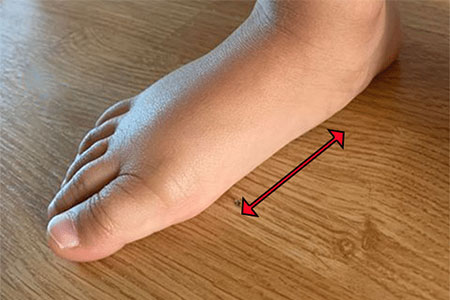

The Challenges of Finding Shoes for Children with Down Syndrome
I know that it can be a challenge for parents to find shoes that are wide enough for their kids’ feet and that at the same time provide the correct amount of support, while still being “socially acceptable.” I have fitted hundreds of shoes for children with Down syndrome and I know which shoe styles come in wide and extra wide widths while providing good support for their feet. These are regular everyday sneakers, not orthopedic shoes.
Some parents don’t understand the importance and the positive impact that shoes can have on their children’s lives. Please remember this: “Any structure built on a weak foundation will collapse”. Our feet are the foundation for our entire body, and we must take good care of them!
Can Shoes Help Improve Your Child’s Stability Issues?
Did you know that children with Down syndrome tend to have stability issues? Wearing the wrong shoe size or the wrong type of shoes will only end up compromising their stability even more and creating all sorts of foot problems. Providing your child with Down syndrome with the correct type of shoes is extremely important since they may not be able to express any discomfort even when they are wearing the wrong shoe size.
When a child is pronating excessively and we don’t do anything to correct it, we are compromising their muscle function since the body has no foundation to walk on. Let me show you the best type of shoes that come in wide and extra wide widths that also provide the best type of support for a child who has Down syndrome.
I will first provide you with a selection of the best shoes for children with Down syndrome that are learning how to walk, and I will provide you with a selection of shoes for older children as well.
First Walking Shoes for Kids with Down Syndrome – Get It Right!

Most children with Down syndrome learn how to walk at an average of 24 months, but some of them might take as long as 42 months. The main reason for this delay is their low muscle tone.
Did you know that shoes play a huge role in foot development? The right type of shoe helps improve your children’s stability, provide them with the everyday support that they need to perform their daily activities, and keeps their feet and legs healthy. Never underestimate the importance of shoes!
I have helped several families who are extremely grateful and shocked about the positive impact that the right type of shoes had on their kids’ lives. I remember one family in particular who came to the shoe store after being referred by their occupational therapist. Their child kept falling and had the hardest time walking.
At first, the parents thought that with time the child’s stability was going to improve and he would stop falling. However, the condition only got worse. The mom was worried that the child was going to hit his head one day and become seriously injured.
Turns out that the child was wearing shoes that were way too long for his feet. The mother told me that she had to get them long for the foot to fit inside the kids’ shoe —since the child had extra wide feet with a high instep— The child had really wide feet, and because the mother didn’t know that deep shoes in extra wide widths existed, she always ended up buying longer shoes.
Think about it: If you wear shoes that are too long for your feet, wouldn’t you keep falling too? I was really upset with the parents, but it was hard to be mad at them when they already felt really badly about the whole situation.
I found a pair of shoes that fit the child’s feet perfectly —the shoe came in extra wide and provided great stability— and when I asked the child to test them out… magic happened! The child was walking and running around the store without a problem! The mother was so happy that she started crying.
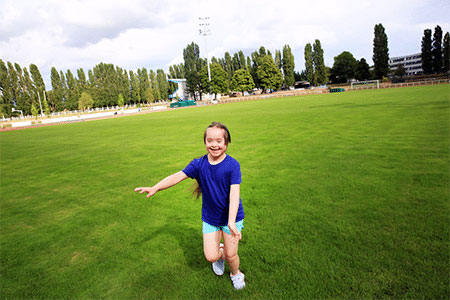
Shoes for Children with Flat Feet! – Get the Most Supportive Styles!
Below you can find some of the most common foot and gait features of children with Down syndrome:
- Smaller toes and feet.
- Flat feet.
- Toe-walking.
- Low muscle tone.
- Decreased ankle range of motion.
- Excessive external hip rotation.
- Stability issues.
If you have noticed that your children have any of the foot conditions described above, a pair of supportive shoes will reduce or eliminate any sort of foot or leg pain that they might be experiencing.
Have you noticed how there is always space below the arch of the foot? This space is what allows for the passage of muscles, tendons, and ligaments that act as springs providing shock absorption every time our feet impact the ground. When a child is flat-footed, the feet can’t act as shock absorbers and that is why we need shoes with good structure and support for their feet!
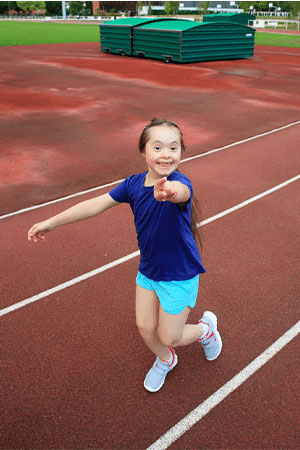
Before and After Images of Children with Flat Feet
I have fitted hundreds of children with Down syndrome in the correct type of shoes, and it’s not an easy thing to do since in most cases you won’t get any feedback from the child. Because I have been doing this for so long, I know exactly how shoes should fit and what type of shoes are best for each particular type of foot. At the children’s shoe store that I work for, I handle approximately 100 hundred fittings/try ons per week.
Take a look at the picture of a flat-footed child, does it look familiar?
Before Image
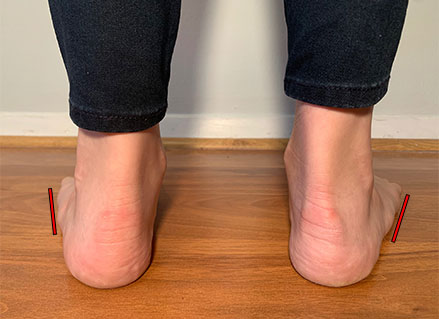
A shoe with good arch and ankle support will help your child walk and run straighter. Something so simple such as providing your children with the correct pair of shoes can have a tremendous impact on improving their overall posture and helping them walk and run straighter.
Now let’s take a look at the same flat-footed child wearing a pair of supportive sneakers. Do you notice how straighter the feet are?
After Image
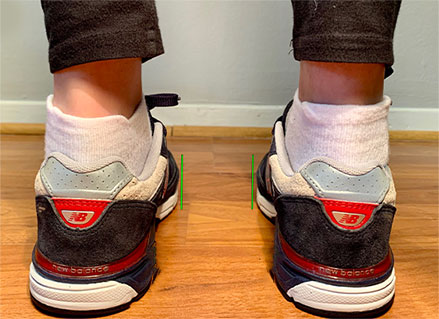
I know which shoes are more supportive than others, and before trying an orthotic, I always start by fitting children in good supportive shoes and observing how they react to them. If the child is still pronating after wearing a pair of supportive shoes, that means that it might be the right time to try a pair of orthotics. However, always start by trying a pair of supportive shoes first.
The Best Shoes for Kids with Down Syndrome
Below you can find a selection of shoes that provide the best support and stability for your kids’ feet. These shoes are also available in medium (M), wide (W), and extra wide (XW). Disclosure: Some links in this post may be affiliate links and we may receive a small commission (at no extra cost to you) when you click our links and make purchases.
Toddler Shoe Sizes (0 to 10)
- Shoe style RaveRun by New Balance
- Available in medium, wide and extra wide widths
- Oversized opening for easy on and off
- Lightweight injection-molded EVA foam midsole provides lightweight cushioning
- Hook and loop closure
- Order this shoe a whole size larger than your toddler’s current foot size
- Shoe style RaveRun by New Balance
- Available in medium, wide and extra wide widths
- Oversized opening for easy on and off
- Lightweight injection-molded EVA foam midsole provides lightweight cushioning
- Hook and loop closure
- Order this shoe a whole size larger than your toddler’s current foot size
- New Balance shoe style 990V6
- Fits children with medium, wide, or extra wide feet
- Hook and loop closure system for easy on and off
- Leather upper
- Order this shoe a half size larger than your toddler’s current foot size
- Shoe style 574 by New Balance
- Available in medium, wide and extra wide widths
- Oversized opening for easy on and off
- No-sew overlays
- Order this shoe a whole size larger than your toddler’s current foot size
- Stride RIte shoe style Wes
- Available in extra wide widths
- Oversized opening for easy on and off
- Leather
- Hook and loop closure
- Order this shoe half a size larger than your toddler’s current foot size
- Shoe style M2P Journey 3.0 by Stride Rite
- Available in extra wide widths
- Oversized opening for easy on and off
- Breathable textile lining is effective in protecting your child’s feet from micro-organisms
- Hook and loop closure
- Order this shoe a half size larger than your toddler’s current foot size
- Shoe style M2P Journey 2 by Stride Rite
- Available in extra wide widths (accommodates high insteps)
- Oversized opening for easy on and off
- Breathable textile lining is effective in protecting your child’s feet from micro-organisms
- Hook and loop closure
- Order this shoe a half size larger than your toddler’s current foot size
- See Kai Run shoe style Robyne
- Fits children with medium, wide, or extra wide feet
- Breathable textile lining and cushioned insole
- Double velcro straps for easy on and off adjustability
- Padded tongue and collar for added comfort
- Order this shoe a half size larger than your toddler’s current foot size
- See Kai Run shoe style Robyne
- Fits children with medium, wide, or extra wide feet
- Canvas upper
- Toe cap is durable for early steps
- Double velcro straps
- Oversized opening for easy on and off
- APMA approved
- Order this shoe half a size larger than your toddler’s current foot size
- New Balance shoe style Fresh Foam 650
- Fits children with medium, wide, or extra wide feet
- Velcro closure
- Leather and mesh upper
- Mesh collar and tongue are padded with foam for a great fit and added comfort
- Extra deep
- Order this shoe a whole size larger than your toddler’s current foot size
- Saucony shoe style Ride 10
- Fits children with medium, wide, or extra wide feet
- Velcro closure
- Leather and mesh upper for durability and breathability
- APMA Certified
- Traction pods on the outsole for serious grip
- EVA midsole for lightweight feel
- Order this shoe a whole size larger than your toddler’s current foot size
- Saucony shoe style Ride 10
- Fits children with medium, wide, or extra wide feet
- Velcro closure
- Leather and mesh upper
- Non-marking traction pods to help improve stability
- APMA approved
- Toe cap for extra durability
- Order this shoe a whole size larger than your toddler’s current foot size
- New Balance shoe style 990V6
- Fits children with medium, wide, or extra wide feet
- Lace-up closure
- Strong rubber outsole and cushioned midsoles
- Suede/mesh upper provides durability and breathability
- Order this shoe half a size larger than your toddler’s current foot size
- New Balance shoe style 990V6
- Fits children with medium, wide, or extra wide feet
- Lace-up closure
- Synthetic/mesh upper provides durability and breathability
- Order this shoe half a size larger than your toddler’s current foot size
Little and Big Kid Shoe Sizes (10.5 to 7)
- New Balance shoe style 990V6
- Fits children with medium, wide, or extra wide feet
- Velcro closure
- Strong rubber outsole and cushioned midsoles
- Suede/mesh upper provides durability and breathability
- Order this shoe half a size larger than your child’s current foot size
- New Balance shoe style Fresh Foam Arishi
- Fits children with medium, wide, or extra wide feet
- Hook and loop closure system for easy on and off
- Mesh collar and tongue are padded with foam for a comfortable fit
- Fresh Foam midsole cushioning is precision engineered to deliver an ultra-cushioned, lightweight ride
- Order this shoe a whole size larger than your child’s current foot size
- New Balance shoe style Rave Run v2
- Fits children with medium, wide, or extra wide feet
- Velcro closure
- Synthetic and engineered mesh upper
- Fresh Foam midsole cushioning is precision engineered to deliver an ultra-cushioned, lightweight ride
- Order this shoe a half size larger than your child’s current foot size
- Shoe style M2P Journey 3.0 by Stride Rite
- Available in extra wide widths (accommodates high insteps)
- Oversized opening for easy on and off
- Breathable textile lining is effective in protecting your child’s feet from micro-organisms
- Hook and loop closure
- Order this shoe a half size larger than your toddler’s current foot size
- Shoe style M2P Journey 3.0 by Stride Rite
- Available in extra wide widths
- Oversized opening for easy on and off
- Breathable textile lining is effective in protecting your child’s feet from micro-organisms
- Hook and loop closure
- Order this shoe a half size larger than your toddler’s current foot size
- New Balance shoe style Fresh Foam 650
- Fits children with medium, wide, or extra wide feet
- Hook and loop closure system for easy on and off
- Mesh collar and tongue are padded with foam for a comfortable fit
- Fresh Foam midsole cushioning is precision engineered to deliver an ultra-cushioned, lightweight ride
- Order this shoe a whole size larger than your child’s current foot size
- New Balance shoe style Fresh Foam 650
- Fits children with medium, wide, or extra wide feet
- Velcro closure
- Strong rubber outsole and cushioned midsoles
- Leather and mesh upper
- Mesh collar and tongue are padded with foam for a comfortable fit
- Order this shoe half a size larger than your child’s current foot size
- New Balance shoe style Fresh Foam 650
- Fits children with medium, wide, or extra wide feet
- Hook and loop closure system for easy on and off
- Synthetic and engineered mesh upper
- Durable rubber outsole designed to withstand wear-and-tear
- Order this shoe a half size larger than your child’s current foot size
- New Balance shoe style Rave Run v2
- Fits children with medium, wide, or extra wide feet
- Hook and loop closure system for easy on and off
- Synthetic and engineered mesh upper
- Durable rubber outsole designed to withstand wear-and-tear
- Order this shoe a half size larger than your child’s current foot size
- The New Balance shoe style RaveRun is available for little and big kids
- Fits children with medium, wide, or extra wide feet
- Available in laces
- No-sew overlays for a sleek fit and feel
- Mesh collar and tongue are padded with foam for a great fit and added comfort
- Order this shoe half a size larger than your child’s current foot size
- The New Balance shoe style RaveRun is available for little and big kids
- Fits children with medium, wide, or extra wide feet
- Available in laces
- Leather and mesh upper
- No-sew overlays for a sleek fit and feel
- Order this shoe half a size larger than your child’s current foot size
- New Balance shoe style Fresh Foam 880v12
- Fits children with medium, wide, or extra wide feet
- Dual-layer midsole construction featuring top-bed foam cushioning and underfoot Fresh Foam X
- Order this shoe a whole size larger than your child’s current foot size
- New Balance shoe style 990V6
- Fits children with medium, wide, or extra wide feet
- Lace-up closure
- Strong rubber outsole and cushioned midsoles
- Suede/mesh upper provides durability and breathability
- Order this shoe half a size larger than your child’s current foot size
- New Balance shoe style Fresh Foam Arishi
- Fits children with medium, wide, or extra wide feet
- Lace-up closure
- Mesh upper is lightweight and breathable
- Lightweight EVA foam cushioning in the midsole and padded heel increases comfort
- Firm heel counter
- Supportive heel for active kids
- Order this shoe a half size larger than your child’s current foot size
- New Balance shoe style 650v1
- Fits children with medium, wide, or extra wide feet
- Lace-up closure
- Dual-layer midsole construction featuring top-bed foam cushioning and underfoot Fresh Foam X
- Order this shoe half a size larger than your child’s current foot size
The type of shoes I recommended are the same ones that most physical and occupational therapists recommend for a child who is flat-footed and has low muscle tone.
Additional Shoe Recommendations for Toddlers with Down Syndrome
- Shoe style SRT Elliot by Stride Rite
- Available in medium, wide, and extra wide widths
- 100% leather made
- Sensory pods to feel the ground beneath for better traction and grip
- Seamless construction that cradles the foot’s natural shape
- Order this shoe a whole size larger than your toddler’s current foot size
- Shoe style SRT Elliot by Stride Rite
- Available in medium, wide, and extra wide widths
- 100% leather made
- Sensory pods to feel the ground beneath for better traction and grip
- Seamless construction that cradles the foot’s natural shape
- Order this shoe a whole size larger than your toddler’s current foot size
- Shoe style SRT Elliot by Stride Rite
- Available in medium, wide, and extra wide widths
- 100% leather made
- Sensory pods to feel the ground beneath for better traction and grip
- Seamless construction that cradles the foot’s natural shape
- Order this shoe a whole size larger than your toddler’s current foot size
This shoe is your classical high top that comes either in brown or white and comes with shoelaces. I know how parents are always trying to stay away from shoes that come with shoelaces, since it is a hassle to have to constantly tie your kids’ shoes. However, a shoe with shoelaces will provide your child with more support and more stability.
Are You Unsure About Which Shoe Size You Should Order Online?
I always recommend that parents take their kids to a local kids’ shoe store that they trust to have their feet properly measured and their shoes properly fitted. However, several parents have contacted me asking where they can get their kids’ shoes online since they don’t have a local shoe store in their area that they trust.
There are definitely several online stores that offer shoes in wide and extra wide widths, but before you start guessing on the shoe size that your child needs, start by reading an article I wrote where I describe the simplest, yet most effective way to retrieve your child’s exact foot length and shape.
Orthotics for Kids with DS – When the Shoes Are Not the Solution!
Physical and occupational therapists will tell you that the earlier you start managing your children’s gait problems, the better. Early intervention will prevent gait problems later down the road, and it will end up saving you a lot of money!
There is a lot of controversy when it comes to how early a child should start wearing orthotics. Many pediatricians and orthopedic surgeons don’t recommend orthotics for children that are younger than 5 years old, stating how children experience significant developmental changes during their first five years.
However, many orthotists and physical therapists, actually believe that it’s important to intervene much earlier. They recommend intervening as soon as the child is 18 months to 2 years of age. However, some recommend orthotic intervention as early as when a child begins to walk. I also agree with the latter recommendation, since I have fitted orthotics for younger kids and have seen the positive impact on the way the child walks and his/her overall posture.
At the children’s shoe store that I work for, we sell shoes and we are qualified to fit orthotics as well. Every time we need to fit an orthotic inside a shoe, we need the shoes to be wider and deeper to accommodate the orthotic (since it takes a lot of space inside the shoe). That’s the reason why we carry every single shoe style that is available in wide and extra wide widths.
How Can Orthotics Help Your Child with Down Syndrome?
The right type of orthotics will play a key role in reducing, or fully eliminating the foot and leg pain that your child might be experiencing. At the kids’ shoe store that I work for, we carry all sorts of orthotics for kids’ and each style serves a different purpose. It is important to take your child to be properly fitted for orthotics, since this requires an experienced person to help you find particular shoe style.
There is one particular orthotic I recommend that has proven to be extremely efficient in preventing children’s feet from collapsing and turning inwards. Let me prove it to you!
Below is a picture of a flat-footed child standing up, do you notice how the feet are collapsing and turning inwards?

Now take a look at a picture of the same child standing up in a pair of supportive orthotics. Do you see how straighter the feet are?
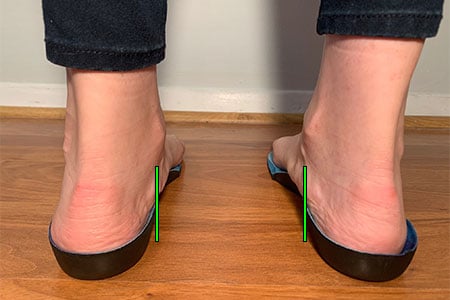
Below you can find the best orthotics for kids that I have fitted before in terms of support and stability:
This orthotic has been specifically designed by podiatrists for pain relieving arch and ankle support. Below you can find the best orthotic for kids with flat feet and overpronation.
Fits Toddler Shoe Size 5 up to Big Kid Shoe Size 3
- Fits a toddler shoe size 5 up to a big kid shoe size 3
- Medically approved insoles with targeted cushion and support
- Deep heel cup with strong arch support
- Made from lightweight yet supportive cushioning material with shock-absorbing heel and forefoot padding
- They can be trimmed to size with scissors if needed
The Best Socks for Kids with Down Syndrome
Did you know that socks play a huge role in keeping your kids’ feet healthy? Some children with sensory issues can’t stand how socks feel and are always taking them off and wearing their shoes without them.
Socks act as a barrier between your kids’ feet and the shoes, preventing the formation and buildup of bacteria inside the shoes. However, I do understand that kids with sensory issues feel every bump and lump and they can’t stand wearing socks with their shoes.
The material that the socks are made of is also important since certain socks retain the moisture from your kids’ feet and some of them repel it! Have you always thought that cotton was the best type of material when it came to socks? I used to believe this, but actually, it’s not! Cotton tends to retain moisture instead of repelling it.
We started carrying seamless socks at the shoe store and some children even call them “magical socks”. I wrote a post where I describe the best seamless socks for children.
Do Children Outgrow Their Flat Feet? – They Don’t Always Do!
I have heard several parents say how they don’t want their kids to become dependent on good, supportive shoes or orthotics, and that they prefer to have their children walk barefoot to strengthen their ankles. Trust me when I tell you that it is a MYTH that orthotics and good supportive shoes interfere with strength development!
I have seen the positive impact that supportive shoes and orthotics can have on children, and in certain cases, they can create a life changing experience.
Several parents have asked me if their children will ever outgrow their flat feet. This is hard to predict, and in most cases, but in most cases, children will remain flat-footed for the rest of their lives. The key is to minimize or eliminate any sort of foot or leg pain that they might be experiencing and allow them to perform their everyday activities without pain.
Wearing the correct type of shoes and orthotics will help improve your kids’ overall posture and minimize or fully eliminate their foot and leg pain.

Further Options to Consider
Do not hesitate to contact me directly via email if you have any further questions or if you need a different pair of shoes for your child. My email address is:
Have you found a particular shoe style for your child with Down syndrome that has worked well for his or her feet? Does your child hate wearing socks and is always pulling them off? Please share your thoughts and experiences in the comments section so we can all benefit from them!



































My son is 22. Have found a few pairs of new balance; size 5 1/2 extra wide but very limited in style. Had a dress shoe “smartfit” wide but seemed wide enough since they had no extra wide. Now outgrown and cannot find dress shoes! Ordered hush puppies size 6 wide width. He says they are too tight. Any suggestions?
Hello Joan,
Have you tried any of the models below?
Option 1 I am not sure if this model will be dressy enough, but it’s available in extra wide widths.
Option 2 You didn’t specify which model you got from Hush Puppies but this style is one of the widest ones.
My daughter loves “option 1” the Billy footwear. But what about dress shoes for women? My 34 year old daughter wears a big kid size 3.5 extra wide!
Hello Barbara,
In that case, you can get a woman’s dress shoe in a size 5 (translates to a kids’ shoe size 3 1/2), or get the kids’ version of the shoes. Do the dress shoes need to be made of a specific color? If you tell me which country you are contacting me from I can send you specific shoe recommendations.
Hello my name is Francine and I love the post I am doing my TCC, final project of course on footwear with down syndrome, I am product design and would like some feed backs and more information and reports of parents who have children with syndrome of downs who want to help me I will leave my email [email protected]
thank you
Hello Francine,
I am sure several families will reach out to you. That is great news that you are coming up with more footwear options for children with special needs.
I am almost in tears. Thank you so much for this page. The picture is exactly what I see when I look at my girls feet and ankles.. But it is mild so she never got an official diagnosis.. I cannot wait to take her to a new balance store and see if this will help and buy her some new socks too.. I am super hopeful, because she loves going on adventures and experiencing stuff really helps her learn, but walking longer distances seems to really bother her.. Oh if this helps her it will be nothing short of a miracle for us. THANK YOU.
Hello Ms. Smith,
Shoes and socks play a key role in keeping our feet and legs healthy and allowing us to participate in different types of activities. Please make sure you ask them to show you either of these styles:
Supportive Shoe for Mild Pronation: Option 1
Supportive Shoe for Mild Pronation: Option 2
If you are willing to tie her shoes, providing your daughter with a pair of shoes that comes with shoelaces will provide her with more support and more stability.
I hope this helps and please keep me posted on how everything works out.
My mom works with a child that has down syndrome and I think she’ll love this information. She always tells me how the child is pulling his shoes off all the time, I think it might be due to the shoes feeling too tight! This is a great piece of information and I wish more parents could know about this.
Mohamed,
If the child keeps trying to take his shoes off he is trying to tell us something is not right. Your mom should make sure that the shoes the child is wearing are the correct shoe size, and definitely play close attention to see if they are wide enough.
I provide in the post a selection of shoes that come in wide and extra wide widths! However, I will recommend taking the child to your closest kids shoe fitting store to make sure he gets the correct shoe size!
I just love this article because I didn’t know that most children that have down syndrome have wide feet. My husband has feet issues and finding that right shoe is so important but at the same time hard because he has wide feet and it’s always hard to find shoes that are wide enough.
Why is it so hard to find shoes for extra wide feet?
Angel,
It’s not hard to find shoes for extra wide feet. I have been fitting children shoes for 7 years and some of these children look like they have frying pans on their feet. I know which shoe styles come in extra wide and certain shoe brands like New Balance tend to make the widest shoes. You should read an article I wrote about shoes that come in extra wide widths:
Children Extra Wide Shoes – Prevent Blisters, Calluses, and Corns!
Hello,
Thank you for thinking about those children with Down syndrome. I know most parents are not aware of what type of shoes a child with Down syndrome needs, and it’s important to understand the importance of providing the child with the correct shoe style and the correct shoe style. I hope they will read this article. I know kids with Down syndrome need wider shoes and also need as much stability as possible, Thank you so much Juan Pablo keep up the good work!
Hello Bob,
The correct type of shoes will not only keep your child’s feet comfortable, but it will also help improve his or her stability! Shoe laces always provide more stability than velcro sneakers, so you should strongly consider providing your child with a pair of shoe laces. You will see what a difference it will make!
Getting the right shoe fit for any child is always a challenge, but it is even harder when you can’t get an input from your child, it’s just makes the process so much more complicated. I’m thankful for people like you providing valuable information for parents and caregivers. The shoes you present look great and at the same time will fit even the widest feet!
Hello Theresa,
Hopefully other parents will find this information valuable as well! I know how hard it is to find the correct pair of shoes for children, so my goal is to make the process simpler for parents. Wide and extra wide shoes are also not easy to find, but I describe where you can find them!
Awesome post! I have met several parents with kids with down syndrome and they always tell me how hard is for them to keep the shoes on and how they are always taking them off! I also like how the socks can help the shoes feel better! This is awesome, thank you for thinking about those kids with down syndrome!
Hello Roamy,
It can be a challenge to find comfortable shoes for kids with Down syndrome. I wanted to provide parents with certain guidelines in order to make their kids, and their own lives easier! I emphasized in the importance of choosing the correct type of socks because if your kid is wearing the wrong type or size sock, there is no way their shoes can feel comfortable!
Could you email me. My downs child is having feet isdues
Ann,
Any question you might have you can send to my email: [email protected]